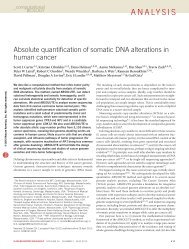Poster Session I (PI 1-106)Displayed 8:00 am – 3:00 ... - Nature
Poster Session I (PI 1-106)Displayed 8:00 am – 3:00 ... - Nature
Poster Session I (PI 1-106)Displayed 8:00 am – 3:00 ... - Nature
You also want an ePaper? Increase the reach of your titles
YUMPU automatically turns print PDFs into web optimized ePapers that Google loves.
aBsTraCTs nature publishing group<br />
effect was lost at a concentration of 1 μM, with only K demonstrating the<br />
significant inhibition of efflux, which was confirmed by patch-cl<strong>am</strong>p.<br />
CONCLUSION: The data demonstrate that the K metabolites<br />
partially (40% relative to nicotine) stimulated the α3β4 NR at 1<strong>00</strong> nM<br />
concentrations and this effect was lost at higher concentrations. The<br />
observed stimulation was inhibited by the NR antagonist mec<strong>am</strong>yl<strong>am</strong>ine<br />
indicating that this was mediated by NR. In addition, the inhibition of<br />
Rb efflux was only seen for K, with weak inhibition by NK, HK1 and<br />
HNK. While for the α7 NR, weak inhibition was observed for all metabolites<br />
except DHNK, which had a pronounced effect, suggesting subtype<br />
selectivity for K and DHNK for NR. The variability observed in treatment<br />
response in depressed patients and chronic pain patients may be<br />
due to individual differences in the metabolism of K.<br />
<strong>PI</strong>-22<br />
HYPERTENSION SUSCEPTIBILITY LOCI ASSOCIATED<br />
WITH BLOOD PRESSURE RESPONSE TO ANTIHYPERTEN-<br />
SIVES- RESULTS FROM THE PHARMACOGENOMIC EVALU-<br />
ATION OF ANTIHYPERTENSIVE RESPONSES (PEAR) STUDY.<br />
Y. Gong, 1 C. W. McDonough, 1 Z. Wang, 2 R. M. Cooper-DeHoff, 1<br />
T. Y. Langaee, 1 A. L. Beitelshee, 3 S. T. Turner, 4 A. B. Chapman, 5<br />
J. G. Gums, 1 K. R. Bailey, 4 E. Boerwinkle, 2 J. A. Johnson 1 ; 1 University<br />
of Florida, Gainesville, FL, 2 University of Texas, Houston, TX,<br />
3 University of Maryland, Baltimore, MD, 4 Mayo Clinic, Rochester,<br />
MN, 5 Emory University, Atlanta, GA. Y. Gong: 1. This research<br />
was sponsored by; Company/Drug; NIH grant U01 GM074492.<br />
C.W. McDonough: None. Z. Wang: None. R.M. Cooper-DeHoff:<br />
1. This research was sponsored by; Company/Drug; NIH grant U01<br />
GM074492, HL084090. T.Y. Langaee: 1. This research was sponsored<br />
by; Company/Drug; NIH grant U01 GM074492. A.L. Beitelshee:<br />
1. This research was sponsored by; Company/Drug; NIH grant<br />
U01 GM074492. S.T. Turner: 1. This research was sponsored by;<br />
Company/Drug; NIH grant U01 GM074492. A.B. Chapman: 1.<br />
This research was sponsored by; Company/Drug; NIH grant U01<br />
GM074492. J.G. Gums: 1. This research was sponsored by; Company/Drug;<br />
NIH grant U01 GM074492. K.R. Bailey: 1. This research<br />
was sponsored by; Company/Drug; NIH grant U01 GM074492. E.<br />
Boerwinkle: 1. This research was sponsored by; Company/Drug; NIH<br />
grant U01 GM074492. J.A. Johnson: 1. This research was sponsored<br />
by; Company/Drug; NIH grant U01 GM074492. 2. I <strong>am</strong> a paid consultant/employee<br />
for; Company/Drug; Medco.<br />
BACKGROUND: To date, 39 SNPs are associated with blood pressure<br />
(BP) in genome-wide association studies (GWAS) in whites. We<br />
assessed the association of these loci with BP response to atenolol<br />
(ATEN) and hydrochlorothiazide (HCTZ), with particular interest in<br />
loci with opposite associations for the two drugs, given their contrasting<br />
pharmacological mechanisms.<br />
METHODS: PEAR evaluated BP response in 768 hypertensive<br />
patients randomized to either ATEN or HCTZ monotherapy then the<br />
combination. Genotypes of 37 loci were obtained from Illumina 50K<br />
cardiovascular or Omni1M GWAS chips. Associations with systolic<br />
(SBP) and diastolic BP (DBP) responses to ATEN or HCTZ mono-<br />
or add-on therapy was evaluated in 464 white individuals using linear<br />
regression adjusting for baseline BP, age, gender and principal components<br />
for ancestry.<br />
RESULTS: Eight SNPs reached nominal significance (p








